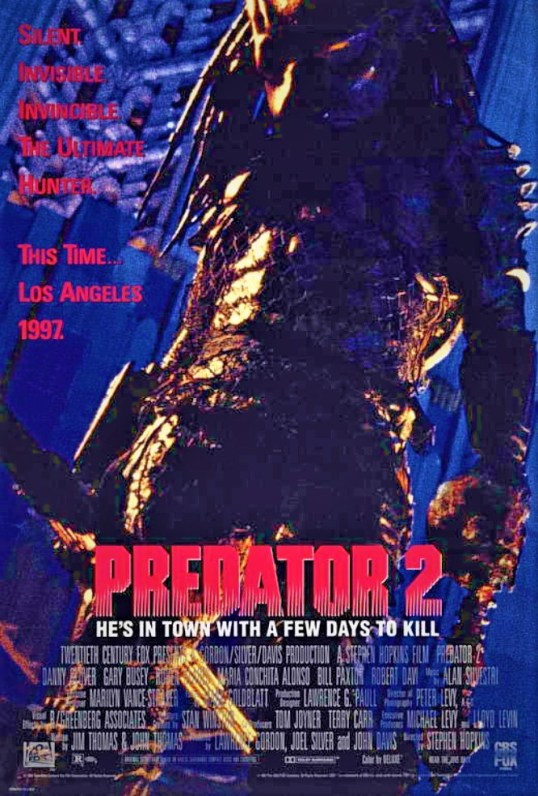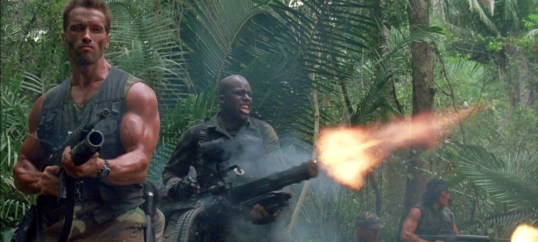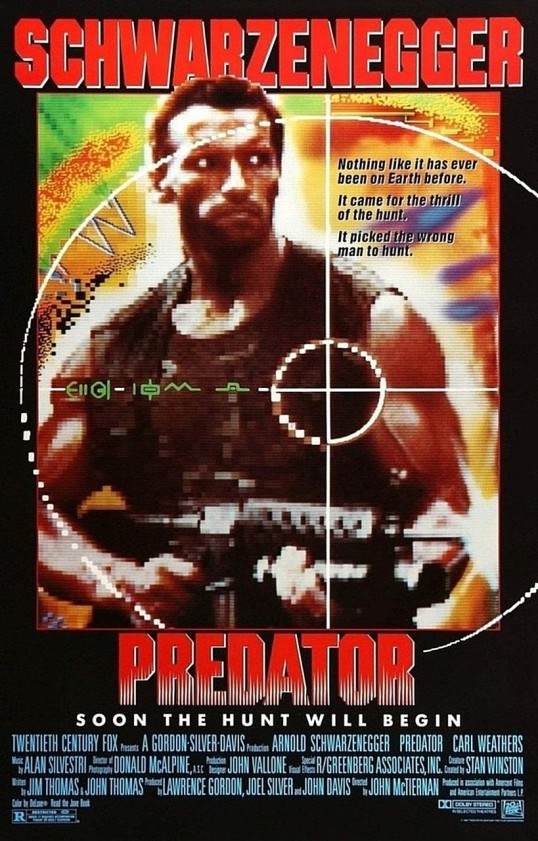Today is John McTiernan’s birthday! Obviously, McTiernan’s career has had its ups and downs but he’s still responsible for directing some of the best action films ever made.
4 Shots From 4 John McTiernan Films
Today is John McTiernan’s birthday! Obviously, McTiernan’s career has had its ups and downs but he’s still responsible for directing some of the best action films ever made.
4 Shots From 4 John McTiernan Films

Like any successful genre film, Predator would remain in the consciousness of filmgoers during the late 80’s. The film was that popular and successful. This also meant that the studio who produced and released the film were more than happy to try and replicate what made them a lot of money. So, a sequel was quickly greenlit within the halls of 20th Century Fox.
Yet, despite the success the first film was able to garner despite some major production problems, this time around luck wasn’t with Predator 2. The follow-up film would have different production issues than the first but they would affect the film in the long run.
First off, John McTiernan wouldn’t be on-board to direct the sequel. His back-to-back successes with Predator and Die Hard has suddenly made him a coveted action director. His schedule would keep him from directing Predator 2 as his slate was already full with The Hunt for Red October being his next film. In comes Stephen Hopkins to helm the sequel.
Yet, the biggest blow to the production would be not being able to get Arnold Schwarzenegger to return in the role of Dutch, the sole survivor of the elite rescue team from the first film. As with most stars and sequels, this time it would be over a salary dispute that would keep Arnold from returning so in comes Danny Glover to take on the sequel’s lead role.
Now, Danny Glover has more than pulled his own action film weight with two Lethal Weapon films already under his belt, but in terms of on-screen charisma he would be a major downgrade from the presence Schwarzenegger provided the first film. But Glover was more than game to take on the role of Lt. Harrigan of the LAPD as the setting for the sequel moves from the steaming jungle canopy of Central America to the blistering asphalt and concrete jungle of gang-ridden Los Angeles.
This change in location made for an interesting take as it helped establish some world building that showed these Predators have visited Earth many times in the past and not just in the faraway jungles but more towards areas and places rife with conflict. We learn that it hunts those who have survived the conflicts of the area they’re in. Only the strongest for these extraplanetary hunters.
Unlike, the original film, Predator 2 fails in not having a cast of characters that the audience could empathize and root for. This follow-up is mostly about action and even more gore than the first. Even the opening sequence tries to one-up the jungle shooting scene from the first film, yet instead of shock and awe the sequence just seems loud and busy,
Predator 2 suffers from a lot of that as the film feels more than just a tad bit bloated. The Thomas brothers (Jim and John) who wrote the original film return for the sequel but were unable to capture lightning in a bottle a second time around. Where the first film was very minimalist in it’s narrative and plot, the sequel goes for the throw everything in but the kitchen sink approach. We have warring drug gangs, inept police leadership, secretive government agencies with their own agendas.
What does work with Predator 2 and has made it into a cult classic as years passed was the very worldbuilding I mentioned earlier. We learn a bit more of this predator-hunter. While some comes as exposition from Gary Busey’s special agent role Peter Keyes, the rest comes from just seeing the new look of this particular Predator courtesy of special effects master Stan Winston.
The biggest joy for fans of the films comes in an all-too-brief scene showcasing the trophy case of the Predator inside it’s spacecraft. Within this trophy case are the skulls of the prey it’s hunted and killed. One skull in particular would ignite the imagination of scifi action fans worldwide. It’s a skull of a xenomorph from the Alien franchise. It made fans wonder if the two films were part of a larger tapestry. Both properties were owned by 20th Century Fox, so there was a chance and hope that the two meanest and baddest alien creatures on film would crossover together.
It would be many, many years before such a team-up would happen. Even when it finally did fans of the franchises would be let down with what they get after waiting for over a decade.
Predator 2 could be seen as trying to make lightning hit the same patch twice or it could be seen as a quick cash grab by a studio seeing a potential franchise. Both are true and without its two biggest stars, Arnold Schwarzenegger and John McTiernan, returning to reprise their roles for the sequel the film was already behind the eight-ball before filming began.
While the follow-up had some interesting new ideas that helped round out the Predator as one of film’s greatest onscreen villains, it also failed to capitalize on those ideas in a creative way. There’s some good in Predator 2, but way too much baggage and too much bad to have it live up to the success and popularity of the original.

I recently reviewed John McTiernan’s classic scifi action Predator. It is a film that many kids both young and those young at heart loved watching on the bigscreen. The 1980’s some would consider the golden years of action filmmaking.
It was a decade where action instead of dialogue ruled. Where muscle-bound stars like Arnold Schwarzenegger and Sylvester Stallone dominated the box-office. Even with the resurgence and current renaissance of the action film genre, many still reminisce about the action flicks of the 80’s and how they truly didn’t make them like they used to.
If there’s ever a great example of just how over-the-top and testosterone-fueled the action films were of this decade of the 80’s (also known as the decade of excess) then one can’t go wrong with showing the uninitiated the jungle shootout scene from Predator.
One doesn’t need to be into guns to appreciate the majesty of this scene.

It would be accurate for one to say that Arnold Schwarzenegger was king of the 80’s action flicks. He first burst onto the scene in the titular role in Conan the Barbarian then it’s follow-up sequel. Yet, it would be his role in James Cameron’s The Terminator in 1985 that would make him a household name.
He began to crank out action films after action film every year to varying degrees of success and quality between 1984 and 1987. It would be in the summer of 1987 that he would add a third iconic action film role to stint as Conan the Barbarian and the relentless cybernetic killer, the Terminator.
Maj. Dutch Schaefer in John McTiernan’s action scifi Predator cemented Arnold Schwarzenegger as the most bankable movie star of the 1980’s. The film itself has become a go-to classic whenever film fans of all stripes discuss what were some of the best films of the era. Yes, I do categorize Predator as one of the best to come out of the 1980’s. It does more than hold it’s own when stacked up against Oscar winners, festival darlings and indie cult-favorites.
It’s a film that takes the premise that “man is the most dangerous game” to new levels by adding in a scifi element to the story. That scifi element being an extraterrestrial hunter who comes to Earth every so often to hunt. It’s chosen prey tends to be killers, fighters and soldiers at the top of their craft and usually during times of extreme conflict.
The film, as written by the two brothers John and Jim Thomas, actually works like a slasher horror film in the beginning as Dutch and his team of elite commandos trek through the Central American jungle on a rescue mission. A mission that lands the team in finding the grisly remains of another American special forces team. Questions come up as to whether their CIA liaison (played by Carl Weathers of Rocky and Rocky II fame) knows more about the true nature of their supposed rescue mission than he’s willing to let on.
It’s once the team, still being stalked through the jungle by an unseen predator, finally find the people they’re suppose to rescue that all hell breaks loose in more ways than one. The action is loud, messy and exquisitely choreographed and filmed. Unlike some of the action films of the last ten years, Predator succeeds with it’s action scenes for having a director who uses very long takes and little to no hand-held to keep the action geography easy to follow and the action choreography unencumbered by too many edits and cuts.
Even once the team realizes that they were now being hunted and that whoever, or whatever is hunting them, the film still continues to stay on a creative track. When I mentioned that the film plays out like slasher film, it does in way in that the titular character behaves and moves like slasher killers. It seems to be everywhere and nowhere. The very victims it’s hunting only see it when it’s too late and death’s upon them.
The film’s dialogue has been quoted by so many fans that memes have been created around them. Yet, this doesn’t mean that the film is hilarious. What it does have was that masculine, brother’s-in-arms banter and quips that’s become a sort of signature for screenwriter and director Shane Black who was hired to do some uncredited rewrites on the Thomas Brother’s original script. Black would also end up playing one of the commandos in the film.
Outside of Arnold himself, Predator would be best-known for the effects work by the late and great Stan Winston, who would come in to help redesign the title character (with some help from his buddy James Cameron) and the rest as they would say was film history. It would be difficult to go anywhere around the world, show the Predator to some random person and they not know what it is.
Predator was one of those films that people, at first, thought was just a mindless, popcorn flick. The type of cinema that was to be seen then forgotten for better fare. Yet, in the end, Predator ended up becoming not just a classic of its genre, but a perfect example of a film that transcends it’s genre roots to become just a great film, in general.
It’s time for another edition of Let’s Second Guess the Academy! This time, we’re taking a second look at the race for Best Picture of 1987.
Can you remember which film won Best Picture for 1987? Don’t feel bad if you can’t because Bernardo Bertolucci’s The Last Emperor is one of the lesser known Oscar winners. The film’s relative obscurity leads to one natural question: was it truly the best film released in 1987?
Or should the Oscar have gone to one of the other films nominated — Broadcast News, Hope and Glory, Fatal Attraction, or Moonstruck?
Let your voice be heard by voting below!
After voting for which nominated film you think should have won, give some thought to some of the 1987 films that were not nominated. Was Moonstruck truly a better film than Near Dark or Full Metal jacket? Ask yourself what would have happened if The Last Emperor hadn’t been released in the United States or what if Fatal Attraction hadn’t been a huge box office smash. What if none of the five best picture nominees had been eligible to be nominated in 1987? Which five films would you have nominated in their place?
Let us know by voting below. As always, you can vote for up to five alternative nominees and write-ins are accepted!
Happy voting!
The video above was released today by 20th Century Fox as part of their marketing machine to help create buzz for their upcoming summer blockbuster scifi film Prometheus.
It’s a clip of a fictional keynote speech by one Peter Weyland at the TED 2023 conference. Guy Pearce plays the role of Peter Weyland and talks about how technology’s influence in human history from the beginning with fire (he mentions the Greek myth of Prometheus stealing the technology of fire from the gods and giving it to man) all the way to artificial intelligence and realistic cybernetic constructs.
Anyone who has been a fan of the Alien franchise will recognize the name Weyland. It’s the fictional transnational corporation which has become a major part of the films in the franchise and, to a degree, even to the Predator franchise. They’re the corporation which sends Ripley and the crew of the ore mining hauler Nostromo to the desolate planet of LV-426 where they encounter the very lifeform that would become one of film’s iconic monsters. It is also the corporation which 70+ years later would send a terraforming colony to the very same planet which would become a major part of the plot for Aliens. Even the David Fincherdirected third film, Alien 3, would use the corporation as the monolithic badguy behind-the-scenes.
Weyland is just part of the corporation’s name as through the years it would combine with another corporation to become Weyland-Yutani. While the aliens in the franchise have been the immediate threat in all the films in the franchise it would be Weyland-Yutani who became the face of the corporate evil that continues to try to get samples of the very alien the franchise is known for.
It’s going to be interesting how this viral video ties into the upcoming Ridley Scott “prequel” to Alien and whether Weyland-Yutani will play a major role in the film’s plot. One thing I’m sure is that Pearce definitely plays a convincing corporate visionary with a God-complex that’s part Steve Jobs and part Richard Branson (if both iconic businessmen channeled their inner-darkside).
Prometheus is set for a June 8, 2012 release date.

Neil Marshall’s follow-up to his cult-favorite werewolf film, Dog Soldiers, has finally arrived in the US. The Descent doesn’t disappoint and I must say that Marshall’s filmmaking skills have dramatically improved since the last time he’s made and released a film. The Descent marks another notch on the resurgence of the horror genre’s return to its darker, meaner and exploitative past when filmmakers weren’t shy about pushing the boundaries.
The film begins with a tragedy that strikes at the heart of one of the women in the film. Sarah’s (played by Shauna MacDonald) tragic losses in the initial beginnings of the film becomes the emotional and psychological foundation that gives The Descent its emotional heft. It turns Marshall’s film from just your typical survival-horror film into one about interesting female group dynamics and the measures people would take in order to survive. The rest of the cast appear pretty quickly. There’s Sarah’s friend Beth (played by Alex Reid) who accompanies Sarah to the US at the invitation of their American friend Juno (played by the hot Natalie Mendoza). This trio of friends are soon joined the trio of Holly (Nora Jane-Noonan) and a pair of sisters in Sam (MyAnna Buring) and Becca (Saskia Mulder). With Juno taking lead in what was to be a bonding weekend for all the ladies, The Descent gradually brings about a heavy sense of dread that something is amiss not just at the activity they’re about to engage in but in the group dynamics within the female group.
The six ladies undertake a spelunking expedition in a cave system in the Appalachian Mountains (already the film takes its first nod of homage to another great film about survival, Deliverance). The outdoor scenes in the woods was actually shot in the forests of Scotland, but one could never guess and Marshall doesn’t linger overmuch in the bright, airy and safe outdoors. Juno soon leads her all-female spelunkers deep into the cave. Their descent into the darkening and gradually oppresive depths of the cave system takes abit longer than necessary, but just when the film was about to become a rehash of Cliffhanger, things suddenly become claustrophobic and the sense that every moment these ladies continue their descent the closer they put themselves into the arms of their inevitable doom.
Things go from bad to worse in a cave-in scene that’s sure to make those with problems of claustrophobia to close their eyes tightly and cover their ears. Except for a few slightly fake looking cave in rocks and debris, this cave-in scene will get hearts pumping and nerves racing. The scene is shot in a very up-close and intimate fashion that the audience has no choice but to feel as if they’re trapped in that barely there tunnel as it begins to collapse around Sarah and Juno. Once the scene is over the ladies soon find themselves cut-off from the only exit they know. One could almost see panic begin to set-in, nerves fray and tempers simmer on the participants. Juno, already established as the alpha-female of the group, continues to take charge of the situation but already her reckless and infectious bravado in the beginning of the film becomes more of a thin veneer hiding a personality that uses such traits to hide a much more duplicitous and cowardly persona.
From this moment of the film until the very final shot (well for the American version at least and more on that later), The Descent takes the meaning of oppresive claustrophobia and magnifies it to the nth degree. Gone are the daylight and open air of the outside forest. Even the upper levels of the cave would be a welcome sight for its stalactites and rock formations glittering from excess water runoff reflecting ambient light. Their descent deeper into the cavern system truly seems like a descent into that primordial fear everyone has since their earliest years: the fear of the dark and the unknown. Then to compound those primordial fears, Marshall adds in the internal conflict and discovered betrayals and secrets within the group dynamic. Its bad enough that these ladies have to contend with the terror of the surrounding darkness and what might dwell in its absence of light, but now personal baggage and secrets puts a new degree of danger to their chances of survival. Steel Magnolias this female-bonding film it is not.
Neil Marshall and his cinematographer, Sam McCurdy, really play with the senses and fears of not just the audience but of the characters trapped in the dark with only a dwindling supply of glowsticks and batteries for their flashlights. The scenes which evokes some of the biggest moments of fright and horror shows nothing on the screen but a blackened, lightless sequence. These scenes impact in terms of horror were compounded by Marshall’s excellent use of sound and its effect in confined, lightless spaces. The audience might not see whats going on in the scene, but we sure could hear every panting, panicky breath random trickling of water that gives an impression of blind, wate torture, and unknown rustles of movement that seem to come in from every direction. The Descent makes great use of the surround sound system in the theater. I noticed more than a few times people looking up and around the theater wondering if the sound is coming from those directions.
The boogeyman or men (and thats using the term very loosely), don’t make an appearance until almost halfway through the film, but the first look the audience get of the Crawlers is bound to give some viewers nightmakes for days to come. The Crawlers themselves were not fully explained and they’re barely seen until the very final reel of the film. Marshall’s decision to let the claustrophobia and disorienting darkness hint more than show in the early stages of their fight against the Crawlers was pivotal one since it kept the monstrous visage of the creatures from becoming overly familiar too soon. Marshall gives us hints of whats stalking the ladies and lets the audiences’ fevered imagination make up the rest. Once the Crawlers are seen abit more fully they’re appearance and behavior do not fail whatever imagined concepts the viewer made. These creatures are fast, vicious and more than abit hungry. The scenes where the Crawlers wreak bloody havoc on Sarah, Juno and the rest of the gang will delight and satisfy fans of gore while making those not used to them quesy to their stomach. Marshall doesn’t go overboard with the gore, but he does shoot and choreograph the violence in an almost lyrical fashion. He’s also made the characters fleshed out enough that the audience wants them to survive and cheer whenever they fight back with a modicum of success.
The Descent is such a refreshing, albeit one that’s also terrifying and pulse-pounding, horror film. It takes the recent resurgence of extreme horror, or goreror as some have called it, but keeps the balance between primal terror and gory disgust. Marshall does a fine job of keeping the story from descending too much into the realm of extreme exploitation. The exploitive nature of the film’s violence is still there, but it never becomes so much as to desensitize and turn away the people its trying to scare and entertain. The film doesn’t bring anything new to the genre. The premise has been done in films such as Alien and Predator. The look of the film once the group is trapped underground even has hints of Argento as Marshall and McCurdy make great use of lighting in an attempt to pierce the solid darkness of the cave.
The last couple years have given fans of the horror genre quite a good list of very good to great films heralding the return of horror to its very hard rated-R roots. Its a place that has been neglected too long by Hollywood and filmmakers, in general. What we really want are horror films that are not just about atmosphere and mood lighting, but also one that’s brutal, nerve-wracking, and adrenaline-pumping. Horror was meant to be in the realm of R and NC-17 and not in the level of PG-13. Neil Marshall has proven that his cult-classic Dog Soldiers was not a fluke. He has shown with The Descent that he’s more than a one-hit wonder. Here’s to hoping that Marshall continues to make great horror and genre films.
